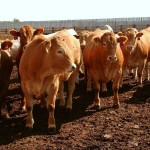Hormone implants and feed additives such as ionophores (e.g. monensin/Rumensin), beta-agonists (e.g. ractopamine/Optaflexx) and MGA (to suppress heat in heifers) have allowed Canada’s feedlot sector to dramatically improve growth rates, feed efficiency and environmental performance. In-feed antimicrobials to prevent liver abscesses (e.g. tylosin) also have an indirect benefit because healthy cattle grow better. While consumers […] Read more
Tag Archives growth promotants

Can we replace growth promotants?
Research on the Record with Reynold Bergen

Growth promotants and the environment
Research on the Record with Reynold Bergen
Growth promotants dramatically improve the growth rates and feed efficiency of beef cattle. Trenbolone acetate (TBA) behaves like testosterone and is used in several feedlot implants (Component, Revalor and Synovex). Melengestrol acetate (MGA) behaves like progesterone, a pregnancy hormone. Some feedlots feed MGA to suppress estrous cycles and riding activity in heifers until a few […] Read more

Devil’s in the detail of China-U.S. beef deal
The announcement on May 4 that China will start accepting U.S. beef on or before July 16 had U.S. industry leaders applauding the Trump administration and excited about supplying this giant market. Their enthusiasm was understandable — U.S. beef has been shut out of China since late 2003, when the U.S. reported its first BSE […] Read more

Performance-improving product approvals for livestock
Research on the Record with Reynold Bergen
Last month’s column summarized a North Dakota State University research project where young female pigs were fed burgers made from tofu or beef from naturally raised or implanted cattle to see whether they reached puberty sooner. They didn’t. That is no surprise, because researchers, pharmaceutical companies and government regulators invest a lot of time, effort […] Read more
Seeking Credibility
Two recent events jumped agriculture’s role in the antimicrobial resistance merry-go-round into high gear. First was the Food and Drug Administration’s (FDA) Final Guidance 213 (December 2013) that established a three-year time frame to end the use of medically important antibiotics as growth promotants. There were also new rules on veterinary oversight related to antibiotic […] Read more



